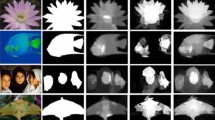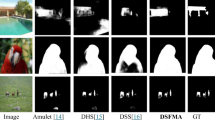Abstract
Current detectors for saliency detection adopt deep convolutional neural networks to continuously improve accuracy, but the results are still not satisfactory. We propose Multiple Receptive Field Aggregating Module (MRFAM) that can capture abundant context information to enhance feature representation. We assemble it into a novel network to predict saliency maps. Extensive experiments on six benchmark datasets demonstrate that the module is efficient and our proposed network can accurately capture salient objects with sharp boundaries in complex scene, performing favorably against the state-of-the-art methods in term of different evaluation metrics.
Access this chapter
Tax calculation will be finalised at checkout
Purchases are for personal use only
Similar content being viewed by others
References
Borji, A., Frintrop, S., Sihite, D.N., Itti, L.: Adaptive object tracking by learning background context. In: IEEE Computer Vision and Pattern Recognition Workshops, pp. 23–30 (2012)
Siagian, C., Itti, L.: Rapid biologically-inspired scene classification using features shared with visual attention. IEEE Trans. Pattern Anal. Mach. Intell. 29(2), 300–312 (2007)
He, J., et al.: Mobile product search with bag of hash bits and boundary reranking. In: IEEE Computer Vision and Pattern Recognition, pp. 3005–3012 (2012)
Bi, S., Li, G., Yu, Y.: Person re-identification using multiple experts with random subspaces. J. Image Graph. 2(2), 151–157 (2014)
Zhu, W., Liang, S., Wei, Y., Sun, J.: Saliency optimization from robust background detection. In: IEEE Computer Vision and Pattern Recognition, pp. 2814–2821 (2014)
Yang, C., Zhang, L., Lu, H., Ruan, X., Yang, M.H.: Saliency detection via graph-based manifold ranking. In: IEEE Computer Vision and Pattern Recognition, pp. 3166–3173 (2013)
Long, J., Shelhamer, E., Darrell, T.: Fully convolutional networks for semantic segmentation. In: IEEE Computer Vision and Pattern Recognition, pp. 3431–3440 (2015)
Xie, S., Girshick, R., Dollár, P., Tu, Z., He, K.: Aggregated residual transformations for deep neural networks. In: IEEE Computer Vision and Pattern Recognition, pp. 5987–5995 (2017)
Szegedy, C., et al.: Going deeper with convolutions. In: IEEE Computer Vision and Pattern Recognition, pp. 1–9 (2015)
Zhang, L., Dai, J., Lu, H., He, Y., Wang, G.: A bi-directional message passing model for salient object detection. In: IEEE Computer Vision and Pattern Recognition, pp. 1741–1750 (2018)
Krizhevsky, A., Sutskever, I., Hinton, G.E.: Imagenet classification with deep convolutional neural networks. In: Advances in Neural Information Processing Systems, pp. 1097–1105 (2012)
Simonyan, K., Zisserman, A.: Very deep convolutional networks for large-scale image recognition. arXiv preprint arXiv:1409.1556 (2014)
Yu, F., Koltun, V.: Multi-scale context aggregation by dilated convolutions. arXiv preprint arXiv:1511.07122 (2015)
Hou, Q., Cheng, M.M., Hu, X., Borji, A., Tu, Z., Torr, P.: Deeply supervised salient object detection with short connections. In: IEEE Computer Vision and Pattern Recognition, pp. 5300–5309 (2017)
Liu, N., Han, J., Yang, M.H.: PiCANet: learning pixel-wise contextual attention for saliency detection. In: IEEE Computer Vision and Pattern Recognition, pp. 3089–3098 (2018)
Zhang, P., Wang, D., Lu, H., Wang, H., Ruan, X.: Amulet: aggregating multi-level convolutional features for salient object detection. In: IEEE International Conference on Computer Vision, pp. 202–211 (2017)
Li, G., Yu, Y.: Deep contrast learning for salient object detection. In: IEEE Computer Vision and Pattern Recognition, pp. 478–487 (2016)
Liu, N., Han, J.: Dhsnet: deep hierarchical saliency network for salient object detection. In: IEEE Computer Vision and Pattern Recognition, pp. 678–686 (2016)
Lee, G., Tai, Y.W., Kim, J.: Deep saliency with encoded low level distance map and high level features. In: IEEE Computer Vision and Pattern Recognition, pp. 660–668 (2016)
Luo, Z., Mishra, A.K., Achkar, A., Eichel, J.A., Li, S., Jodoin, P.M.: Non-local deep features for salient object detection. In: IEEE Computer Vision and Pattern Recognition, pp. 6609–6617 (2017)
Wang, L., Wang, L., Lu, H., Zhang, P., Ruan, X.: Saliency detection with recurrent fully convolutional networks. In: Leibe, B., Matas, J., Sebe, N., Welling, M. (eds.) ECCV 2016. LNCS, vol. 9908, pp. 825–841. Springer, Cham (2016). https://doi.org/10.1007/978-3-319-46493-0_50
Wang, T., Borji, A., Zhang, L., Zhang, P., Lu, H.: A stagewise refinement model for detecting salient objects in images. In: IEEE International Conference on Computer Vision, pp. 4019–4028 (2017)
Zhang, P., Wang, D., Lu, H., Wang, H., Yin, B.: Learning uncertain convolutional features for accurate saliency detection. In: IEEE International Conference on Computer Vision, pp. 212–221 (2017)
Acknowledgments
This research was supported by the National Natural Science Foundation of China (Grant Nos. 11627802, 51678249), by State Key Lab of Subtropical Building Science, South China University Of Technology (2018ZB33), and by the State Scholarship Fund of China Scholarship Council (201806155022)
Author information
Authors and Affiliations
Corresponding author
Editor information
Editors and Affiliations
Rights and permissions
Copyright information
© 2019 Springer Nature Switzerland AG
About this paper
Cite this paper
Zheng, T., Li, B., Rao, H. (2019). Enhancing Feature Representation for Saliency Detection. In: Lu, H., Tang, H., Wang, Z. (eds) Advances in Neural Networks – ISNN 2019. ISNN 2019. Lecture Notes in Computer Science(), vol 11555. Springer, Cham. https://doi.org/10.1007/978-3-030-22808-8_43
Download citation
DOI: https://doi.org/10.1007/978-3-030-22808-8_43
Published:
Publisher Name: Springer, Cham
Print ISBN: 978-3-030-22807-1
Online ISBN: 978-3-030-22808-8
eBook Packages: Computer ScienceComputer Science (R0)




